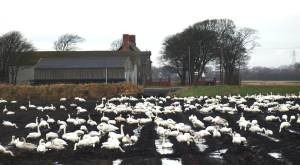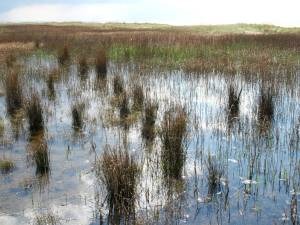Dr Phil Smith’s Wildlife Notes
November 2008
A particular highlight this month was the news from Derek Forshaw of a record number of Pink-footed Geese in Lancashire and North Merseyside. The co-ordinated count on 2nd produced an amazing total of 90,455, of which about 24,000 were on the Ribble Estuary and 20,000 at Martin Mere. This follows on from the previous record count in October and may be due to bad weather during harvest time resulting in more grain etc. being left in the fields. Usually, many of the birds have flown on to Norfolk by early November to feed on waste from the sugar-beet crop but I understand that, at the time of the count, few geese had arrived in East Anglia.
Also making the news was the annual influx of Whooper Swans, mainly from Iceland. At Martin Mere, these had reached an impressive and noisy total of 1230 by 25th. Visiting bird-watchers were also entertained by six or seven different birds of prey on a daily basis. Whoopers were also feeding on Halsall Moss during the month, Derek Williams reporting a peak of 766 on 24th. Meanwhile, Marshside had its usual hoards of ducks and waders, including the Ribble’s now resident Glossy Ibis which turned up again in the middle of the month.

Little Egrets seem to be increasing all the time and I heard that up to 80 were counted at Freckleton on the north Ribble. They are certainly a fixture at Marshside now, as many as 20 being seen on 7th. Several are roosting at night on one of the Southport Marine Lake islands. The closely related Cattle Egret is also spreading north from the continent, a pair having bred in Somerset this year. One was seen at Marshside but the first multiple sighting in Lancashire was of three associating with a flock of sheep at Downholland Cross, which I rushed over to see on 1st.
The more usual winter visitors included four Snow Buntings on Ainsdale beach and several reports of Woodcock; I managed to see two of these elusive, well-camouflaged waders during dune walks. There was also a notable influx of Jack Snipe. This is a bird one has virtually to tread on before it flies. One of the big dune slacks produced 15 of these stripy skulkers, while smaller numbers were on Birkdale Green Beach, where I also flushed a Water Rail. Unfortunately, I missed the three Pale-bellied Brent Geese on Birkdale shore from 22nd. Twelve or more Crossbills were in the pines at Fisherman’s Path and I was pleased to hear the characteristic flight call of one flying north over Ravenmeols woods.

The Formby Black Poplar hunt that I reported on in October continued throughout November, more specimens being found at Range Lane, Larkhill and the area west of St Luke’s Church. The grand total is now approaching 500!
Finally, Graham Jones of the Lancashire Wildlife Trust sent me details of 69 different moths that he and Richard Burkmar recorded in just two August visits on Birkdale Green Beach. They include a new species for Lancashire and one not seen in the region since the 1950s. These records add further to the already sky-high reputation of this fabulous wildlife habitat.
